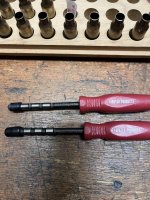@RegionRat have you ever seen dry neck lube impact accuracy?
TLDR: Yes
What we call "neck tension" on an open forum is vague, but for a moment lets pretend it means seating force.
(To keep things simple, lets us pretend the seating force is due to (the condition and neck prep of the brass) times (the friction coefficient). We are discussing both at the same time, not just one or the other.)
Now ask yourself if seating force affects accuracy?
This turns into another "it depends" answer doesn't it? Because seating force versus accuracy/precision can be a deep rabbit hole, my answer is going to sound vague, so I apologize in advance.
In the real world of defense/aerospace, we burned big budgets to make things work but that is not the same as saying we always burned enough to explain the mechanics of why. If we had reliable answers with solid statistics, we often settled for not knowing why as long as things were proven to be very reliable.
Many times we could not explain why one weapon system was picky about seating force, while another was not, but both kinds exist.
We had many theories but none of the customers wanted to wait for another science project to explain the deep physics if their project was otherwise ready for use.
For a moment, lets say seating force MAY affect starting pressure and combustion. The caps are for emphasis because there can be a wide window of seating force that is forgiving in some instances, but in other instances it may be picky.
Let's assume we are talking about pre-loaded ammo, and not BR where folks tune on the spot. Let us also assume we are not discussing blasting ammo, where the time of flight is short range and MV stats don't matter.
In some guns/ammo, the neck tension can be a sensitive issue, and yet in others you can swing it pretty wide and see no significant change in group stats even if the POI moves a little. When we can manage the DOPE and the group stats remain tight, we are happy. But...
In other guns/ammo, when we shift the neck tension average a little, we get in and out of tune. Also keep in mind, unless you know the seating force values, meaning the average and the ES/SD of those forces, you are not part of this discussion.
I was often forced to deal with ammo that was required to be neck-sealed and crimped, versus other ammo that was not sealed or crimped. We found ways to make both work well, but in the end we always did everything we could to make the seating force SD/ES stats as small as possible.
Keeping the stats on the neck prep, and seating forces tight was done regardless if we thought there was a correlation to performance. Remember, Uncle Sam spends 99.99% of your tax dollars on loading, and has very little interest in re-loading.
There are some differences between making virgin ammo versus reloading used brass, but the deep ballistics answers were the same.
When we tested that neck tension issue, there was a connection to the MV statistics and that is why you are better off keeping your seating force workmanship as tight as possible.
Could someone come on and show a gun that doesn't care if the seating force can be doubled with horrible stats yet still shoot tight? Yes.
Could someone show a direct correlation between seating force, MV average, MV SD, and MV ES, and target performance, yes.
However, to keep moving forward we need to filter out all the anecdotal inputs where folks really don't know the neck tension/seating force. There is enough chaos in the study without all the noise from folks who have no clue.
My advice is the following, take it or leave it...
When your choice at home is to spend a great deal of resources to test everything and you enjoy doing the shooting, then by all means run with it. Do the testing.
However, if you don't have all the resources and barrels/bullets/etc., to burn testing that much, you would be better off keeping neck tension workmanship under control, tight control.
If I make ammo I care about, and it might have to sit for months, or to travel to some distance place to be used, you can be sure I am controlling the tribology of the friction in the necks as well as the hardness of the brass in the necks.
Yes, I personally use all the tricks when it matters the most to me, and work hard to avoid mass producing crappy ammo. I can sound like a hypocrite because I also mass produce blasting ammo that I just anneal and tumble, but trust me I know the neck tension stats even on that junk because folks I care about might be risking their fingers and eyes shooting my rigs.
Sorry for the long answer. YMMV


